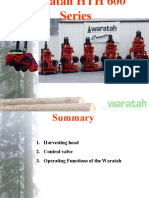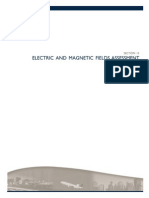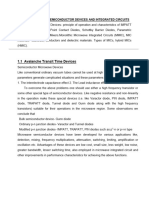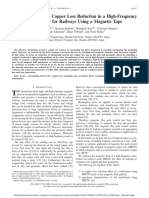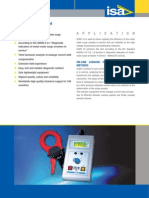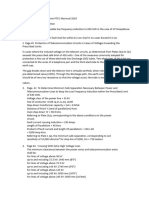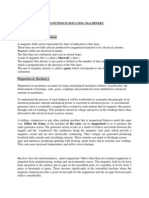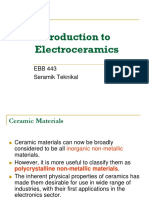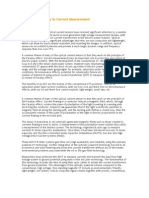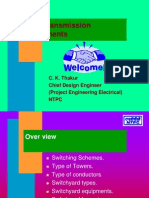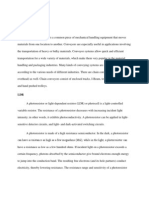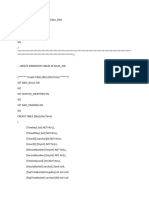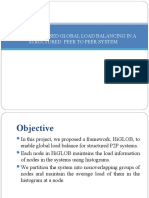TimeMedical PICA Interferencias
TimeMedical PICA Interferencias
Uploaded by
Jose FariasCopyright:
Available Formats
TimeMedical PICA Interferencias
TimeMedical PICA Interferencias
Uploaded by
Jose FariasCopyright
Available Formats
Share this document
Did you find this document useful?
Is this content inappropriate?
Copyright:
Available Formats
TimeMedical PICA Interferencias
TimeMedical PICA Interferencias
Uploaded by
Jose FariasCopyright:
Available Formats
SERVICE DOCUMENT
4.3 MAGNETIC FIELD CONSIDERATION
The surroundings of the MRI site(s) must be examined very carefully. It is important to check for
magnetic interference or fluctuation due to external field sources, moving metallic objects or other
causes at an early stage of the project.
The first consideration in site planning is the interaction of the fringe field with objects that come within its
range. Contact Time Medical Systems for advice on magnetic field and its effect on existing installation.
The fringe field contour around the magnet is visualized as spheroid.
4.3.1 SOURCES OF MAGNETIC FIELD FLUCTUATIONS
Building steelworks and reinforcements within 6m of the magnet iso-center affects the magnetic field
homogeneity within the measuring area of the magnet. Details should be provided to Time Medical
Systems of beams and columns in excess of 100kg/m around the shield room and reinforced concrete
2
or steel beams up to 40kg/m below the magnet. These pieces of information allow Time Medical
Systems to ensure that the magnet will reach the required specifications.
The need for magnetic compensation and the shielding method is determined according to the
quasi-static (DC < 5Hz) and slow changing magnetic field fluctuation (AC 16-20Hz; AC 50-60Hz).
Maximum Acceptable Magnetic Fluctuation Values
without Magnetic Compensation Requirements
DC (<5Hz) 1mG 100nT
AC (16.6Hz) 0.2mG 20nT
AC (50-60Hz) 1mG 100nT
Table 3: Maximum Acceptable Magnetic Fluctuation
3500WB-02 QI 1.4.10 - CE Page 23
SERVICE DOCUMENT
4.3.2 INTERFERENCE CONSIDERATION
Common sources of magnetic interference are fluctuating loads on adjacent power lines, radio or
television transmissions, heavy-duty transformers, elevator motors and similar electromagnetic devices.
Consult Time Medical Systems for concerns about the proximity of electromagnets, elevators, loading
docks, parking areas, and etc.
Maintain a minimum distance between magnet and anything that can cause a detrimental effect on the
field homogeneity or the structural integrity of the magnet. Conditions that may interfere with the magnet
include (but not limited to) a wall with metal sheathing or steel studding, a concrete support column with
steel reinforcing bars, and cryogenic storage area containing steel dewars. Analyze each site carefully to
ensure optimum performance of PICA.
Source of Interference Minimum Distance
- AC 50Hz or 60Hz >10m
- AC 50Hz or 60Hz: transformers, fans >10m
- AC 16.6Hz or other train frequencies >400m
- Moving iron (dynamic interference)
<50kg: e.g. wheel trolleys >5m
200kg: e.g. patient table >7m
900kg: e.g. cars, small elevators >9m
>4500kg: e.g. trucks, large elevators >15m
>20000kg e.g. big trucks, excavators >25m
DC cables from trams or subway >50m
Table 4: Minimum Distance to Source of Interference
3500WB-02 QI 1.4.10 - CE Page 24
SERVICE DOCUMENT
Objects that Affect Magnetic Field
15-gauss line or All ferromagnetic construction materials except small amounts
2
closer of steel reinforcing bar, normally not exceeding 11kg/m
2
(2.5lb/ft. )
5 to 15 gauss Presence or movement of ferromagnetic objects over 45kg
(100lbs): pushcarts, hand trucks, gas cylinders and etc.
2 to 5 gauss Presence or movement of ferromagnetic objects over 450kg
(1000lbs): small delivery trucks, automobiles, pallet movers,
forklifts, elevators and etc.
1 to 2 gauss Presence or movement of ferromagnetic objects over 34000kg
(75000lbs): trains, large trucks and etc.
Objects Affected by Magnetic Field
15-gauss line or Cardiac pacemakers, ferromagnetic implants, and unrestrained
closer ferromagnetic objects: tools, keys, electronic equipment,
analog watches, magnetic data storage media, credit cards and
etc.
5 to 15 gauss Cardiac pacemakers and electronic equipment: shielded CRTs,
computers, shielded image intensifiers, shielded
photomultiplier tubes and etc.
2 to 5 gauss Very sensitive electronic equipment: unshielded image
intensifiers, photomultiplier tubes and etc.
1 to 2 gauss Extremely sensitive electronic equipment: linear accelerators,
electron microscopes, CRTs and etc.
Table 5: Interaction between Common Objects and Magnetic Field
4.3.3 SERVICE LINE
The permissible magnetic flux density B (magnetic induction) for the AC, three-phase power meter is B
≤2mT.
Magnetic shielding must be provided at higher magnetic flux densities to ensure the proper operation of
the AC and three-phase power meter.
--End of Section--
3500WB-02 QI 1.4.10 - CE Page 25
You might also like
- Trilogy of Wireless Power: Basic principles, WPT Systems and ApplicationsFrom EverandTrilogy of Wireless Power: Basic principles, WPT Systems and ApplicationsNo ratings yet
- A Presentation On Summer Training at Assam Electricity Grid Corporation LTDDocument47 pagesA Presentation On Summer Training at Assam Electricity Grid Corporation LTDAshis karmakarNo ratings yet
- IR Value For Electrical Cable and WiringDocument9 pagesIR Value For Electrical Cable and WiringSyamraj JayarajanNo ratings yet
- It Is Quite Another Electricity: Transmitting by One Wire and Without GroundingFrom EverandIt Is Quite Another Electricity: Transmitting by One Wire and Without GroundingRating: 4.5 out of 5 stars4.5/5 (2)
- Acca IfrsDocument109 pagesAcca Ifrsesam5278No ratings yet
- Service Training 2005Document76 pagesService Training 2005Heidi Cuevas Venegas100% (1)
- Measurement of Electric & Magnetic Field of Transmission Line (400kv, 200kv) & at SubstationDocument19 pagesMeasurement of Electric & Magnetic Field of Transmission Line (400kv, 200kv) & at SubstationAbhay KumarNo ratings yet
- Section 15 - Dec 2004Document87 pagesSection 15 - Dec 2004voonyvrNo ratings yet
- PTCUL Substation Training ReportDocument24 pagesPTCUL Substation Training ReportChetan Sharma100% (1)
- One Word AnsDocument65 pagesOne Word Ansss_chinniNo ratings yet
- Magnetostrictive ActuatorsDocument2 pagesMagnetostrictive Actuatorsdellibabu509No ratings yet
- UNIT4_7Document14 pagesUNIT4_7yashsharnagat9No ratings yet
- Stray Current in DC Railway SystemDocument10 pagesStray Current in DC Railway SystemfaarigNo ratings yet
- Importance of Transformer Demagnetization-OffcialDocument7 pagesImportance of Transformer Demagnetization-Offcialoedis100% (1)
- Stray Current in DC Railway SystemDocument10 pagesStray Current in DC Railway Systemjunaraso53No ratings yet
- Alternating-Current Copper Loss Reduction in A High-Frequency Transformer For Railways Using A Magnetic TapeDocument7 pagesAlternating-Current Copper Loss Reduction in A High-Frequency Transformer For Railways Using A Magnetic TapeperjjNo ratings yet
- SCAR10Document3 pagesSCAR10Sukant BhattacharyaNo ratings yet
- Distribution Transformers EMCDocument8 pagesDistribution Transformers EMCmazinmaazNo ratings yet
- MIIM OverviewDocument10 pagesMIIM OverviewManoj KumarNo ratings yet
- Distribution Transformers and EMCDocument8 pagesDistribution Transformers and EMCДрагана ШкипинаNo ratings yet
- Elctronic Flo MTRSDocument14 pagesElctronic Flo MTRSShoeb ShaikhNo ratings yet
- Introto ACPDDocument11 pagesIntroto ACPDKittikun JitpairodNo ratings yet
- Findings From PTCC Mannual 2010Document3 pagesFindings From PTCC Mannual 2010krishna kumar bhardwajNo ratings yet
- Magnetism in MachineriesDocument3 pagesMagnetism in MachineriesGAGANNo ratings yet
- X10378 Inductive Loads Remedies Issue 1Document2 pagesX10378 Inductive Loads Remedies Issue 1Sina MehrabafiNo ratings yet
- Design of Transmission Line Using MatlabDocument12 pagesDesign of Transmission Line Using Matlabdensus88 densus89No ratings yet
- Part 1Document16 pagesPart 1anasariqi1000No ratings yet
- Tutorial 3 AnswersDocument7 pagesTutorial 3 AnswersEden BerteteNo ratings yet
- Ceramics Tech #ElectroceramicsDocument51 pagesCeramics Tech #Electroceramicsnawa100% (2)
- Korona SensörüDocument11 pagesKorona SensörüMetin VaranNo ratings yet
- Microwave Solid State Devices, Microwave MeasurementsDocument52 pagesMicrowave Solid State Devices, Microwave MeasurementsSnigdha Siddu100% (1)
- Review of Principle and Analysis of Wave Guide: Sem. II, 2016/17 Microwave Devices and Systems by WaltengusDocument26 pagesReview of Principle and Analysis of Wave Guide: Sem. II, 2016/17 Microwave Devices and Systems by WaltengusYibe JoseNo ratings yet
- Emi NotesDocument70 pagesEmi NotessangavaimanoNo ratings yet
- Electromagnetic Induction of Ultrasonic Waves: Emat, Emus, EmarDocument8 pagesElectromagnetic Induction of Ultrasonic Waves: Emat, Emus, EmarVuong Tran VanNo ratings yet
- Chapter 1-Introduction To ElectroceramicsDocument51 pagesChapter 1-Introduction To ElectroceramicsMaria Cecilia Nobrega100% (2)
- Solid State Surge Arresters For HV-PfistererDocument17 pagesSolid State Surge Arresters For HV-Pfistererrasheed313No ratings yet
- Optical Technology in Current MeasurementDocument2 pagesOptical Technology in Current MeasurementAnoop Ravi50% (2)
- Guide To Solving AC Power Electromagnetic Field Problems in Commercial BuildingDocument20 pagesGuide To Solving AC Power Electromagnetic Field Problems in Commercial BuildingRick LohNo ratings yet
- Slides Part3Document25 pagesSlides Part3shubham singhNo ratings yet
- IPST03Paper9d 4 PDFDocument6 pagesIPST03Paper9d 4 PDFCarlos Lino Rojas AgüeroNo ratings yet
- 2 M-2 Ie Rules On GTD (Ier 74-93)Document9 pages2 M-2 Ie Rules On GTD (Ier 74-93)Govindappa RNo ratings yet
- Unit Iii OvervoltagesDocument16 pagesUnit Iii Overvoltageslvb123No ratings yet
- O & P Setting CalculationDocument94 pagesO & P Setting CalculationNeelakandan Masilamani75% (4)
- Dubex Semina ProposalDocument18 pagesDubex Semina Proposalannamichelle1001No ratings yet
- Unit 4.3Document44 pagesUnit 4.3syed1188No ratings yet
- Elimination of Electromagnetic Interference in Transformer StationDocument14 pagesElimination of Electromagnetic Interference in Transformer Stationh_salkicNo ratings yet
- ElectroceramicasDocument51 pagesElectroceramicasLuis Ramírez CaroNo ratings yet
- SwitchyardDocument29 pagesSwitchyardjogiyajeeNo ratings yet
- Unit 6 Introduction To MicrowaveDocument22 pagesUnit 6 Introduction To MicrowavemohanbabuNo ratings yet
- Ziomek 1995 ISH - Relationship Between Residual Gas Pressure and Microdischarge Activity in Vacuum - Small FileDocument4 pagesZiomek 1995 ISH - Relationship Between Residual Gas Pressure and Microdischarge Activity in Vacuum - Small FileWaldemar ZiomekNo ratings yet
- Mo 201Document53 pagesMo 201Fatin Nur AshyqinNo ratings yet
- Master Induction Type Overcurerent Relay PanelDocument29 pagesMaster Induction Type Overcurerent Relay PanelLKNo ratings yet
- Conveyor SystemDocument7 pagesConveyor SystemMarvs RomeroNo ratings yet
- About Power SupplyDocument17 pagesAbout Power SupplyAnonymous DjWqKpZ1No ratings yet
- Chapter - 1 Power Electronics ControlDocument0 pagesChapter - 1 Power Electronics Controlwww.bhawesh.com.npNo ratings yet
- Experiment No-6 SGPDocument21 pagesExperiment No-6 SGPSaroj kumar BiswasNo ratings yet
- Avalanche Transit Time Devices: Kunal Kant Singh Rajya Khatoon ECE (7 Sem.) Cist, BhopalDocument16 pagesAvalanche Transit Time Devices: Kunal Kant Singh Rajya Khatoon ECE (7 Sem.) Cist, Bhopalraman yarramilliNo ratings yet
- EarthingDocument26 pagesEarthingBoopathi MayavanNo ratings yet
- Introduction to Power System ProtectionFrom EverandIntroduction to Power System ProtectionRating: 5 out of 5 stars5/5 (1)
- Pig Iron Making: Dr. Saleem Shuja The University of LahoreDocument23 pagesPig Iron Making: Dr. Saleem Shuja The University of Lahoremissing wonder100% (1)
- Vcs Appnote Hares WaitDocument8 pagesVcs Appnote Hares Waitsunilg786No ratings yet
- EPI 2.07 Community DiagnosisDocument3 pagesEPI 2.07 Community DiagnosisJoher MendezNo ratings yet
- AL 2.4 - EthicsDocument8 pagesAL 2.4 - EthicsJessa ParedesNo ratings yet
- Devoir de Contrôle N°2 - Anglais - 7ème (2016-2017) Besma Belhadj PDFDocument3 pagesDevoir de Contrôle N°2 - Anglais - 7ème (2016-2017) Besma Belhadj PDFchampion malekNo ratings yet
- Atlas ImageDocument1 pageAtlas Imagerandallsworld3dNo ratings yet
- Mechanical Maintenance PresentationDocument132 pagesMechanical Maintenance Presentationgopalakrishnannrm1202100% (4)
- Department of Computer Science and EngineeringDocument3 pagesDepartment of Computer Science and EngineeringVSBCETC EXAM CELLNo ratings yet
- Enterprise Resource Planning (ERP)Document15 pagesEnterprise Resource Planning (ERP)Ankita BoradeNo ratings yet
- BTS4175SGA: Smart High-Side Power SwitchDocument26 pagesBTS4175SGA: Smart High-Side Power SwitchDanny Alexander Bodegas pinedaNo ratings yet
- Financial Appraisal Framework 20 - 03 - 2023Document31 pagesFinancial Appraisal Framework 20 - 03 - 2023SakareSreenivasNo ratings yet
- AMMAR AKL Electric ResumeDocument4 pagesAMMAR AKL Electric ResumeENG AMMARNo ratings yet
- Chapter 08 - Combined StressesDocument16 pagesChapter 08 - Combined StressesJohn Eduard GallegoNo ratings yet
- Financial Management Part 2: Lecturer: Dr. Ann Downer, EddDocument2 pagesFinancial Management Part 2: Lecturer: Dr. Ann Downer, EddMark Anthony EllanaNo ratings yet
- Nirosta 4104: Krupp EdelstahlprofileDocument2 pagesNirosta 4104: Krupp EdelstahlprofileLuis MayorgaNo ratings yet
- 1.launch The Below URL's in Firefox BrowserDocument6 pages1.launch The Below URL's in Firefox BrowserRani raniNo ratings yet
- PowerDocument4 pagesPowerAhmadTobasiNo ratings yet
- Demo DWDocument85 pagesDemo DWnguyentranminhnhatkdNo ratings yet
- Module 6 Study Outline (July To December 2011) r1Document16 pagesModule 6 Study Outline (July To December 2011) r1ingmiri100% (1)
- Basic Installation and Start-Up Guide For MASTERDRIVES MC and GMC Software PackagesDocument25 pagesBasic Installation and Start-Up Guide For MASTERDRIVES MC and GMC Software PackagesPassenger MedeamNo ratings yet
- Wopq Format Asme Qw-360Document1 pageWopq Format Asme Qw-360Anonymous S33n8gNo ratings yet
- Service Bulletin Copier: SubjectDocument9 pagesService Bulletin Copier: Subjectoleg-spbNo ratings yet
- MCQ Transportation Law Part 4Document5 pagesMCQ Transportation Law Part 4bam zeppeleinNo ratings yet
- Reading Line of TextDocument4 pagesReading Line of TextTheophilus ParateNo ratings yet
- Histogram Based Global Load Balancing SystemDocument19 pagesHistogram Based Global Load Balancing SystemRam KumarNo ratings yet
- Virtual and Augmented Reality ECC4351Document63 pagesVirtual and Augmented Reality ECC4351KeertanaNo ratings yet
- CIS Microsoft SQL Server 2012 Database v1 5 0 Level 1 AWS RDS - AuditDocument30 pagesCIS Microsoft SQL Server 2012 Database v1 5 0 Level 1 AWS RDS - Auditahw0000007No ratings yet
- Integrated Goods and Service Tax (IGST)Document21 pagesIntegrated Goods and Service Tax (IGST)Avinash As AviNo ratings yet





